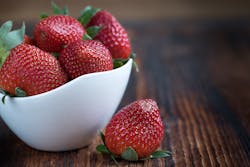A word association game among lighting industry geeks might go like this: Question — Fluence? Answer — Cannabis. Rightfully so, as the legalization of cannabis has been a big driver of the horticultural lighting firm’s growth to $141 million in revenue in 2021, eight years after starting up.
But it’s not all about cannabis at Austin, TX-based Fluence by Osram, the company that Signify is acquiring for $272M in cash, and which should boost Signify’s already growing horticultural revenue stream.
As a reminder of its crop diversity, Fluence has posted results of a year-long project in which it examined the effects of tunable lighting on strawberry crops in greenhouses. Working with Dutch horticultural research institute Delphy Improvement Centre in Bleiswijk, Holland, Fluence experimented with various spectra, noting the impact on yields, plant height, Brix levels (sugar), and other attributes.
“Results from our collaboration with Delphy are showing that strawberries thrive under predominantly white spectra, creating opportunities for greenhouse growers to introduce new, efficient lighting strategies into their facilities,” said David Hawley, Fluence principal scientist for Fluence. “Strawberry cultivars grown under a broad spectrum with a fraction of far-red saw taller crops, wider canopies, higher overall yields, and increased Brix values.”
The team examined four types of light — white, white with a fraction of far-red, pink, and pink with a fraction of far-red. It applied the variations to two popular European strawberry varieties, Sonata and Sonsation.
The white with a fraction of far-red proved to be the most advantageous. Under that spectra, Sonatas grew 68% taller with a 28% wider canopy, and Sonsations grew 40% taller with a 29% wider canopy, compared to under the pink spectrum. Fluence noted that “taller and wider crops are easier to harvest, and enable better air movement across plants, discouraging pathogens that would thrive in more dense, humid environments.”
White with a fraction of far-red also recorded 11% and 14% higher yields for Sonatas and Sonsations, respectively, compared to all pink. Yields included “waste” used for jams and juices.
Brix levels were 14% higher for Sonatas and 6% higher for Sonsations, compared to those grown under all pink.
Fluence did not release comparison figures for the other two spectral categories — all white and pink with far-red.
“With an optimized lighting strategy, growers can produce crops with delicious flavors that consumers demand, and yields that enable store shelves to remain stocked year-round,” said Fluence CEO David Cohen.
While Fluence will continue to talk the talk of the often rough- and-tumble cannabis business, it will also walk the walk of fruit and vegetables.
MARK HALPER is a contributing editor for LEDs Magazine, and an energy, technology, and business journalist ([email protected]).
For up-to-the-minute LED and SSL updates, why not follow us on Twitter? You’ll find curated content and commentary, as well as information on industry events, webcasts, and surveys on our LinkedIn Company Page and our Facebook page.

Mark Halper | Contributing Editor, LEDs Magazine, and Business/Energy/Technology Journalist
Mark Halper is a freelance business, technology, and science journalist who covers everything from media moguls to subatomic particles. Halper has written from locations around the world for TIME Magazine, Fortune, Forbes, the New York Times, the Financial Times, the Guardian, CBS, Wired, and many others. A US citizen living in Britain, he cut his journalism teeth cutting and pasting copy for an English-language daily newspaper in Mexico City. Halper has a BA in history from Cornell University.





